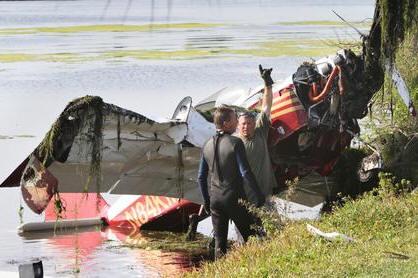 |
|
|
|
|
|
|||
|
By |
||||
 |
April 13, 2010 - The NTSB issued a preliminary report on the experimental, amateur built Cupaiole RV-6A aircraft that crashed, N84KM, while departing Palm Beach Country Park Airport (LNA), Florida on April 3, 2010, about 12:15 PM.
The amateur built
aircraft was operated by a commercial pilot, Michael Cupaiole of
The certificated
commercial pilot was killed. The personal flight was conducted under the
provisions of 14 Code of Federal Regulations Part 91. Visual
meteorological conditions prevailed and no flight plan was filed for the
planned flight to Palm Beach County Glades Airport (PHK), |
|||
|
The airplane
was based at
The Cupaioleís wife reported that he usually purchased fuel at PHK. The
airplane subsequently departed runway 9. Shortly after takeoff, the
witnesses heard the engine noise cease. The airplane then turned right
and descended nose-down in to a lake, about 1/8 mile east of LNA.
The airplane was recovered and brought to a hangar for examination. The
FAA inspector noted that all major portions of the airplane were
accounted for. Two propeller blades did not exhibit damage, while one
propeller blade separated about mid-span. The airframe forward of the
aft bulkhead was partially crushed. Both wings sustained impact damage
and the main cabin structure was compromised. Both wings remained
attached to the airplane and both exhibited compression damage to the
forward spar. Both fuel tanks were compromised. The FAA inspector
planned to examine the airplaneís engine at a later date.
Cupaiole, age 58, held a commercial pilot certificate, with ratings for
airplane single-engine land, airplane multiengine land and instrument
airplane. He also held a certified flight instructor certificate, with
ratings for airplane single-engine land, airplane multiengine land, and
instrument airplane. |
||||
|
Cupaiole
most recent FAA second-class medical certificate was issued on March 8,
2010. At that time, the pilot reported a total flight experience of
3,500 hours. The Cupaioleís wife reported that of the 3,500 hours of
total flight experience, about 600 hours were in the accident airplane.
The two-seat,
low-wing, fixed tricycle gear airplane, serial number 60564, was issued
an FAA experimental airworthiness certificate on February 17, 2004. It
was powered by a Lycoming O-320, 150-horsepower engine. According to the
pilotís wife, the airplane had accumulated about 600 total hours of
operation. |
| ©AvStop
Online Magazine
Contact
Us
Return To News
|
|
